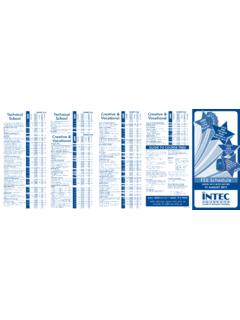Transcription of Annex A: Suggested model for the safe management of ...
1 DISTRIBUTION Sarah Chaker HSE London 2012 Team Helen Bolt HSE, Construction, Communications and Programme management Adrian Tinson HSE, Entertainment Sector Giles Meredith HSE, FOD Construction Sector Andrew Maxey HSE, FOD Construction Policy Alec Ferguson London Organising Committee of the Olympic Games (LOCOG) Andy Lenthall Production Services Association (PSA) Dan Wilson Craw Made-up Textiles Association (MUTA) Steve Miller London Borough of Newham Paul Thomas HSE, FOD Construction Sector Phil Deebank HSE, Portfolio Holder for Construction Processes and management Simon Armitage HSE, Occupational H&S Science Co-ordination Unit Andrew Curran HSL, Science and Resources Director Paul Bridges HSL, Unit Head Engineering Safety Unit Michael Stewart HSL, Technical Lead Engineering Safety Unit Shuna Powell HSL, Unit Head Human Sciences Unit This report and the work it describes were funded by the Health and Safety Executive (HSE).
2 Its contents, including any opinions and / or conclusions expressed are those of the authors alone and do not necessarily represent HSE policy. Report Authorised for Issue by: Paul Bridges, Engineering Safety Unit, HSL Date of issue: 7th December 2011 Final Version Contributing Authors: Paul McCann Project Manager: Paul McCann Technical Reviewer: Dr Michael Stewart Julie Bell Editorial Reviewer: Dr Paul Bridges HSL Project Number: PH04152 HSE Upside Number: OH2212 Crown copyright (2011) PRIVACY MARKING: Available to the public. Harpur Hill, Buxton Derbyshire, SK17 9JN T: +44 (0)1298 218000 F: +44 (0)1298 218590 W.
3 Identification of safety good practice in the construction and deconstruction of temporary demountable structures Annex A Suggested model for the safe management of temporary structures ES/FE/11/01/A Paul McCann BEngEngineering Safety Unit iii ACKNOWLEDGEMENTS HSL would like to thank all of the individuals and companies that have provided their advice and support in the compilation of this report.
4 HSL would like to extend particular thanks to those who made us welcome on their sites, often during periods of high activity and to those who facilitated those visits by making initial contacts. iv FOREWORD Each year, the UK holds a number of large events including sports, musical and corporate events. These events require extensive provision of temporary demountable structures (TDS) such as staging, seating, temporary buildings, video screens, camera platforms, etc.
5 In 2012, London will host the Olympic and Paralympic Games. The requirement for temporary demountable structures will be beyond anything undertaken in the UK for previous events and is likely to extend beyond the venues to include cultural and other events. This will put pressure on the associated supply chain in terms of capacity and experience. The provision of temporary demountable structures is influenced by factors that may have less significance in other industries such as speed of erection and deconstruction, limited use, adaptability of design, transportability and use by public.
6 management structures in the events industry are often less formalised than in other comparable industries. There have been failures of these types of structures, in the UK and beyond, including a recent incident in France, in which two died when a temporary stage roof collapsed during erection. HSL have undertaken a review of current management practices in the events industry, which is published in tandem with this work (HSL report ES/FE/11/01). This review identified potential weaknesses in some areas of the event management . This Suggested model seeks to clarify the good practice standards required for the safe design and construction management of temporary demountable structures.
7 The model includes recommendations for designers, clients, event managers and those workers involved in erection/deconstruction. v CONTENTS 1 1 2 DEFINITION OF 2 3 MANAGING THE 4 Selecting the 4 management Hierarchy .. 4 Time and 5 The Event Site or 5 4 DEVELOPING THE CONCEPT OF THE STRUCTURE .. 6 Determining the Design Concept .. 6 Time and 6 Managing the Location.
8 7 Sponsors .. 7 5 DEVELOPING THE STRUCTURAL DESIGN .. 8 Competency .. 8 Time and 8 Identification of Hazards .. 9 Designing for Construction / 9 Verification and Modification .. 10 Development of Erection Plan .. 10 Note on Novel 10 6 BUILDING THE 12 management of the Event Site .. 12 management of Interlocking Roles .. 12 Competency .. 13 Time and 13 Monitoring and Review .. 13 management of the Structure 13 14 Change Control .. 15 7 16 Operating Conditions .. 16 Damage and 16 TDS Support .. 16 8 18 management of 18 management of Interlocking Roles.
9 18 management of the Structure Deconstruction .. 18 vi 9 19 Agreed Lines of 19 Input to and Agreement of the Design Concept .. 19 Input to and Communication of the 19 Communication of 19 Site Briefings .. 20 Feeding 20 Documentation .. 21 10 SUMMARY OF 22 11 27 1 1 INTRODUCTION Each year, the UK holds a number of large events including sports, musical and corporate events.
10 These can take place at a range of locations from city centres to remote green field sites. Sports stadia and arenas are commonly used as venues for events other than sports. Event organisers are frequently required to provide infrastructure as well as extensive provision of temporary demountable structures (TDS) including staging, seating, temporary buildings, video screens and camera platforms. The providers of temporary demountable structures are influenced by factors which may be far less significant to other industries, such as ease of erection and deconstruction, limited use, adaptability of design, transportability and use by public.
















